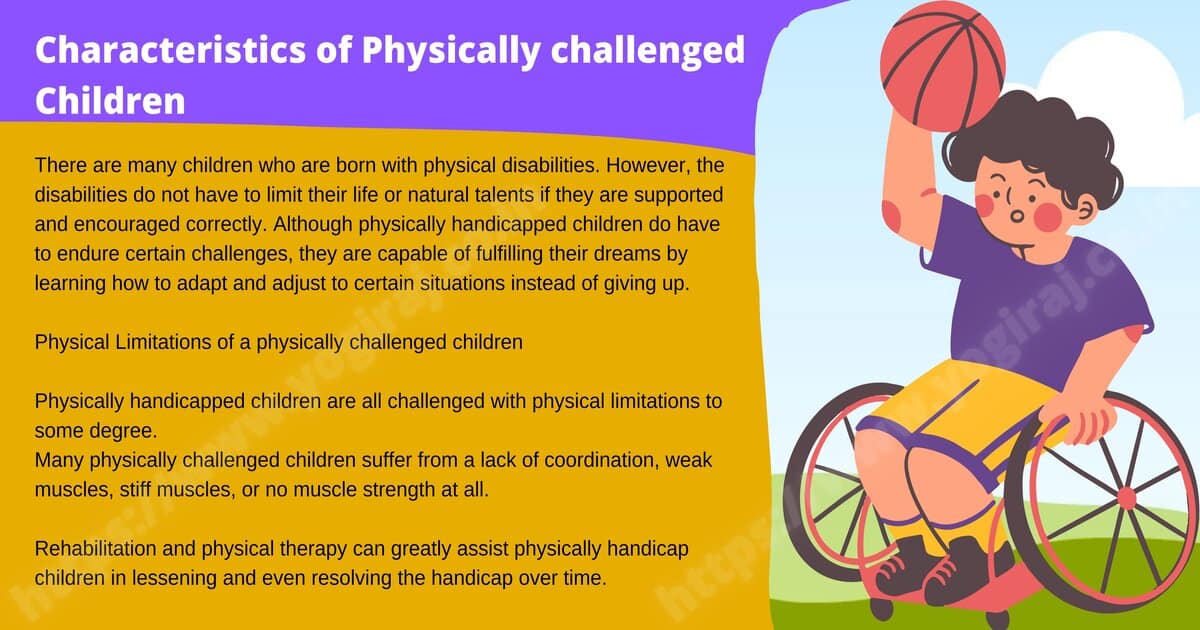Characteristics of Physically challenged Children
by Yuvi - November 21, 2020
Characteristics of Physically challenged Children.
There are many children who are born with physical disabilities. However, the disabilities do not have to limit their life or natural talents if they are supported and encouraged correctly. Although physically handicapped children do have to endure certain challenges, they are capable of fulfilling their dreams by learning how to adapt and adjust to certain situations instead of giving up.
Physical Limitations of a physically challenged children
Physically handicapped children are all challenged with physical limitations to some degree.
Many physically challenged children suffer from a lack of coordination, weak muscles, stiff muscles, or no muscle strength at all.
Rehabilitation and physical therapy can greatly assist physically handicap children in lessening and even resolving the handicap over time.
All of the necessary equipment and safety measures should be taken in order to allow the child to be as mobile and independent as possible.
Emotional Challenges of a physically handicapped child
It is important for parents, family members, friends, and teachers to monitor a physically disabled child’s emotional state.
At times, physical limitations can lead to frustration, anger and sadness.
The emotional outlook of the child is often directly impacted by the level of support and encouragement that is received from the people around him.
It is important for physically disabled children to have people that they can talk to openly in order to discuss, understand, and resolve emotional issues.
In some cases, it is beneficial for the physically challenged child to see a therapist or enroll in a therapy program with animals or physical activities that increase his confidence.
Learning Abilities of physically handicapped children
Although some children with physical disabilities also have mental disabilities many children are mentally strong and just as capable as any other child.
It is important that parents and teachers encourage physically handicapped children to excel in school and discover their individual talents and strengths.
With the correct support and encouragement physically handicapped children can succeed in school and even surpass other classmates. Parents and teachers must recognize the gifts of the child and not limit them mentally because of physical disabilities.
5. Difficulty in sitting, standing, walking
6. Poor motor control
7. Shaky movements
8. Difficulty in picking, holding and putting things.
Characteristics of physically handicapped children
Physically handicapped students generally have average or above average intelligence. Dykes (1984-85) suggest 85% of health impaired and 35% of orthopedically handicapped children are served in special schools or classes. Often their needs vary. The greater needs of the physically handicapped children are in the areas of adaptive equipment’s. Often they require wheel chairs, crutches, head pointers, arm and leg braces.
Technological gap has narrowed down the gap in providing adequate educational instruction to students who can not speak move or use hands.
Physically handicapped children are passive, less persistent having shorter attention span, engage them in less exploration and display less motivation.
They are more dependent on adults, and interact less with peers. Facilitating independence and building self esteem are the two requirements for the physically handicapped children.
The physically disabled has poor body image, high anxiety, and frustration. They are found to be quiet, conforming, tender minded and somewhat tense. Social relationships constitute a problem area for many crippled youngsters. Their capacity for frustration tolerance is lower than normal children.
Difficulties of orthopedically handicapped arise out of several factors. Essentially children with motor disabilities are not very different from normal boys and girls. Their handicap arises out of three factors:
a. Society’s attitude towards them.
b. Child’s interpretation of this reaction to his limitation.
c. Discrepancy between aspiration and achievement.
Because of neurological impairment and experimental impoverishment they do show perceptual difficulties.
Intelligence of the orthopedically handicapped children does not basically differ from those of normal except for cerebral palsy. The neuro- muscularly impaired children function 10 to 15 points between estimated intelligence.
Children with cerebral palsy, muscular dystrophy, and hydrocephalic are included in the dull normal classification while other children with the orthopedic disability are within the normal range.











